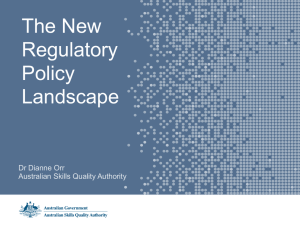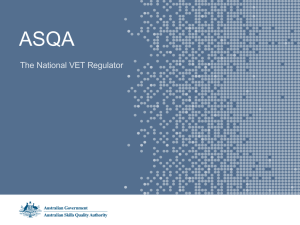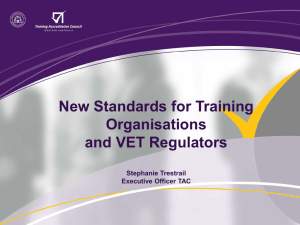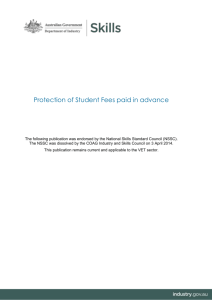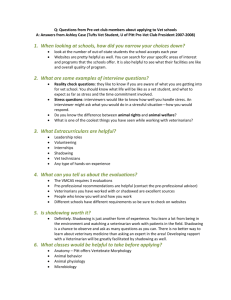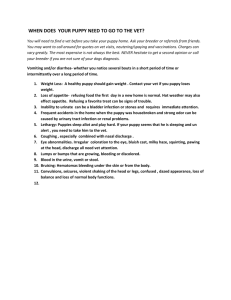Proposed Standards for training providers and VET
advertisement
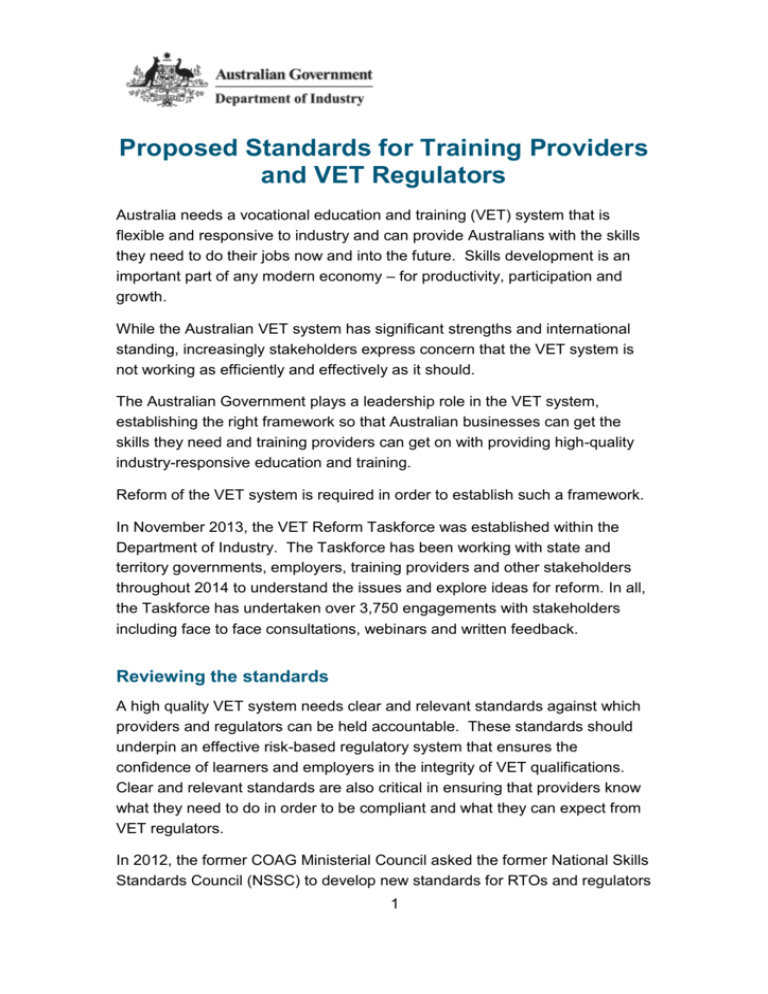
Proposed Standards for Training Providers and VET Regulators Australia needs a vocational education and training (VET) system that is flexible and responsive to industry and can provide Australians with the skills they need to do their jobs now and into the future. Skills development is an important part of any modern economy – for productivity, participation and growth. While the Australian VET system has significant strengths and international standing, increasingly stakeholders express concern that the VET system is not working as efficiently and effectively as it should. The Australian Government plays a leadership role in the VET system, establishing the right framework so that Australian businesses can get the skills they need and training providers can get on with providing high-quality industry-responsive education and training. Reform of the VET system is required in order to establish such a framework. In November 2013, the VET Reform Taskforce was established within the Department of Industry. The Taskforce has been working with state and territory governments, employers, training providers and other stakeholders throughout 2014 to understand the issues and explore ideas for reform. In all, the Taskforce has undertaken over 3,750 engagements with stakeholders including face to face consultations, webinars and written feedback. Reviewing the standards A high quality VET system needs clear and relevant standards against which providers and regulators can be held accountable. These standards should underpin an effective risk-based regulatory system that ensures the confidence of learners and employers in the integrity of VET qualifications. Clear and relevant standards are also critical in ensuring that providers know what they need to do in order to be compliant and what they can expect from VET regulators. In 2012, the former COAG Ministerial Council asked the former National Skills Standards Council (NSSC) to develop new standards for RTOs and regulators 1 to improve quality in the VET sector. The NSSC developed a set of draft standards for providers and regulators and sought comment from the sector. Concerns were raised that some of the proposals in the NSSC draft were impractical and would have added unnecessary cost and regulation on providers. In addition, the draft standards fell short of meeting the Government’s new deregulation agenda. The inaugural meeting of the COAG Industry and Skills Council (with membership comprising Commonwealth, state and territory ministers with portfolio responsibility for industry and/or skills) on 3 April 2014, considered the issues and concerns about the VET sector and agreed on a reform agenda. The Chair of the Council, the Hon Ian Macfarlane MP, Commonwealth Minister for Industry, tabled the concerns raised by stakeholders through the VET reform process. In response, Ministers agreed to six reform objectives with three priority areas for immediate action. One of the three key priorities to be addressed immediately was dealing with the draft NSSC standards. Priority Action: examine the standards for providers and regulators to ensure they better recognise the different level of risk posed by different providers, enable the regulators to deal more effectively with poor quality in the sector to improve confidence, and meet the Australian Government’s deregulation objectives. The VET Reform Taskforce, in conjunction with key stakeholders from training and support services providers and industry, has revisited the work undertaken by the NSSC. The Taskforce considered the range of stakeholder views on the NSSC's draft standards, including revisiting the 300 submissions made to the NSSC. The Taskforce also took account of the issues raised during the broader VET reform consultation process, including: Stakeholders called for a risk-based approach to regulation that recognises the risk related to the provider (for example, size, type of provider or type of training delivered) rather than a ‘one-size-fits-all’ approach. Training providers feel weighed down by red tape, endless process and excessive regulation. Stakeholders noted that high quality providers 2 are not rewarded for their compliance and that low quality providers are still allowed to operate. There were concerns about the quality of VET graduates, in particular that some graduates lack the necessary skills for the workplace. Some stakeholders suggested that to achieve quality training outcomes there should be a stronger focus on training and assessment in the standards, including a greater role for industry. The standards are ambiguous and the Australian Skills Quality Authority (ASQA) should have a role in educating training providers on what compliance looks like. Providers were also after a greater degree of consistency of auditing within ASQA and between VET regulators. The standards should be outputs and outcomes focused rather than inputs focused. New provider and regulator standards Following the consultations, new draft standards have been prepared and support three key themes: industry responsiveness, quality outcomes and less onerous regulation. The standards focus on ensuring a real role for industry and improving quality assurance. Industry responsiveness is a key priority for the Government and was an important issue raised by stakeholders. To deliver job-ready graduates that meet the skills and productivity needs of employers, industry needs a stronger role in the system. The new standards introduce important changes such as strengthening requirements for registered training organisations (RTOs) to engage with industry and to use that engagement to inform their training and assessment strategies. Another priority area for government and for training providers is reducing the burden of regulation. Reducing costs and regulatory burden for RTOs is a key theme of the VET reform agenda. The new standards represent a first step towards establishing a transparent VET system that rewards high quality providers. The standards also focus on providing clarity to RTOs so they have a clear understanding of what it means to be compliant while allowing VET regulators to better deal with poor providers. 3 In line with this approach, the new draft provider standards remove several of the more contentious reforms proposed by the former NSSC that would have added to the regulatory burden in the sector without achieving a commensurate improvement in quality. The standards also introduce stronger requirements around information provision and marketing of training courses to consumers to enable them to make informed decisions about their training. The standards also strengthen arrangements in relation to subcontracting of training and assessment. The new standards contain much clearer requirements for RTOs in relation to advertising and marketing of courses. These address the findings in ASQA’s Strategic Review of marketing and advertising practices, which was conducted in 2013. In addition, the new draft regulator standards provide greater clarity and consistency around the roles and responsibilities of VET Regulators in different jurisdictions. This will enable providers to better understand what to expect from the regulatory system. The draft provider and regulator standards are the first instalment in the Government’s commitment to moving towards a more modern and responsive regulatory model, acknowledging that the “one size fits all” approach is not working effectively. In conjunction with the work on the standards, the Government is committed to ensuring that the national regulator, ASQA, is supported to change their operating arrangements. There are three key elements of this new approach that will occur in the short term. Firstly, the regulator standards reinforce the role of regulators in providing general education and guidance materials to providers to assist them to comply with the standards. Prior to the new standards coming into effect, ASQA will provide sufficient information to the sector so that providers are clear about what compliance with those new standards means. Secondly, ASQA will be focusing further on poor providers and will, where necessary, take action to sanction them. 4 Thirdly, ASQA will have a renewed focus on service and will provide better education and support to training providers. The Government has indicated that it is looking at options for a different way of funding ASQA that will support these changes. These key elements sit alongside the findings of the recently released ASQA Process Review. This review identified six main themes that will deliver the highest value to ASQA's efficiency and effectiveness and benefit the VET sector. The Government is committed to creating a modern regulatory environment that is responsive to industry needs and reduces burden for high quality training providers and will work in partnership with ASQA to further enhance its regulatory service and operations in response to the process review. Consultation process On 25 June 2014, the Hon Ian Macfarlane MP, Minister for Industry, released revised RTO and VET Regulator Standards for public consultation. The VET Reform Taskforce welcomes all feedback from stakeholders on any aspect of the new standards. There are also a number of key issues within the RTO standards where a range of views have been put forward previously and there are various ways the standards could be drafted. These key issues are explored below. Feedback is also welcome on these specific issues. Interested stakeholders can submit their feedback on the revised standards to vettaskforce@industry.gov.au. The closing date for submissions is 17:00 (AEST) Wednesday, 23 July 2014. Further information on how to connect with the VET Reform Taskforce on the consultation process is available at www.vetreform.industry.gov.au. Next steps Following the public consultations on the draft standards, a final draft will be prepared for consideration by the COAG Industry and Skills Council. It is intended that the revised standards will come into effect from 1 January 2015. 5 Overview of the RTO Standards 1. Industry responsiveness One of the strengths of the national training system is that it is industry-led. However stakeholders have expressed concerns about the responsiveness of the system in helping people to acquire the skills that employers need now and in the future. Employers and industry have made it clear that training is not always relevant and tailored to their current and future needs and in some cases is provider-driven rather than industry-driven. Industry engagement and relevance The new standards strengthen the requirement for an RTO’s training and assessment to be relevant to industry and informed by meaningful industry engagement. The standards define industry engagement to cover a range of activities such as partnering with local and regional employers, involving employer nominees in industry advisory committees, embedding staff within enterprises, networking with peak bodies and developing networks of relevant employers and industry representative to participate in assessment validation. However, in response to stakeholder feedback that engagement with industry should be outcomes rather than inputs focused, it is insufficient for RTOs to only demonstrate that they have engaged with industry. RTOs will also be required to demonstrate how engagement with industry has informed their training and assessment strategies so they are relevant to the needs of industry. RTOs will also need to demonstrate how industry engagement has ensured the current industry skills of its trainers and assessors. Strengthening the link between training packages and delivery There have been concerns that some RTOs are not consistently interpreting, delivering and assessing the requirements specified by industry in training package units and qualifications. Employers have expressed concerns that graduates are leaving the system without the required skills to do their job properly, undermining confidence in the VET system to provide employers with a reliable signal about the knowledge and skills that an individual possesses. 6 ASQA’s recent strategic reviews have also uncovered poor quality training and assessment being delivered in some sectors, particularly in relation to the duration of training programs. Some were found to be too short to enable students to sufficiently develop the skills required to work in the sectors examined. This is of major concern to both industry and training providers. The new provider standards strengthen the requirement for RTOs to design, develop and deliver training and assessment in a way that will enable students to gain the skills, build the competencies and knowledge that industry has defined as necessary to perform effectively in the workplace. The new standards require RTOs to ensure their training and assessment strategies and practices are consistent with the requirements specified in training packages, including any volume of learning requirements. Industry engagement is covered in Standard 1. 2. Quality of training and assessment The VET system needs to deliver high quality training outcomes to provide students with the skills they need to support them in their current and/or future jobs and to provide employers with a reliable indicator about the knowledge and skills a graduate holds, regardless of where they were trained. Stakeholders have consistently raised concerns about the lack of relevant jobready skills held by some VET graduates and very short courses and training periods that have led to stakeholders commenting on the delivery of “tick and flick” training. There are a range of responses required to improve the quality of outcomes within the sector and only some of those can be achieved through the standards. There is also a role for VET regulators to operate on an informed risk-management approach to ensure RTOs are equipped to deliver good quality outcomes, training packages that are developed with industry and include the right requirements, and good consumer information so that potential students and employers can make informed choices. The new standards aim to improve the quality of training outcomes through requiring RTOs to have appropriately skilled trainers and assessors and ensuring that RTOs are held fully accountable for the quality of training 7 outcomes, irrespective of whether they outsource the delivery of training and assessment. Appropriately skilled trainers and assessors To achieve quality outcomes in the VET sector, the delivery of training and assessment is paramount. Delivering high quality training and assessment relies on the skills and knowledge of trainers and assessors. This means that the quality of the training and assessment of to those undertaking the minimum qualification for trainers and assessors is of vital importance. Minimum requirements for trainers and assessors The draft NSSC standards retained the arrangements for specifying the minimum training and assessment competency requirements of all trainers and assessors, and industry’s role in specifying any additional qualifications, experience and/or industry currency required for an assessor through the relevant Training Package or accredited course. However, the draft NSSC standards refined and enhanced the minimum requirements of trainers and assessors by removing the allowance for equivalence of competencies. This was in response to considerable feedback suggesting the current standards do not place sufficient discipline on trainers to attain the minimum qualification (the Certificate IV in Training and Assessment). The draft NSSC proposal to remove the allowance for equivalence of competencies would have been introduced immediately had the NSSC standards came into effect. In keeping with the former NSSC’s proposal, the new standards seek to strengthen training and assessment in the system by enshrining qualification requirements in the standards themselves. The new standards also remove the equivalence of competencies rules for trainers and assessors. However, it does this in a phased way giving providers time to manage the transition while balancing the need for trainers and assessors to hold these important qualifications. Minimum requirements for trainers and assessors is covered in clauses 1.111.13 and for individuals training under supervision see clauses 1.14-1.17. 8 Delivery of the Certificate IV in Training and Assessment The NSSC consultation process also raised the issue of the quality of the delivery of the Certificate IV in Training and Assessment and noted that this has attracted concern and poor audit results for some time. The draft NSSC standards proposed to increase the scrutiny and monitoring of providers that deliver the Certificate IV in Training and Assessment. This included introducing independent and external validation and increasing the minimum qualification of those delivering the Certificate IV to the Diploma level. Given the importance of training and assessment qualifications in enabling trainers to effectively design and deliver industry-current skills training, the new standards retain the NSSC requirement that RTO’s who deliver the Certificate IV in Training and Assessment to undergo independent and external validation of their assessment system in relation to the Certificate IV. The new VET regulator standards also include a requirement that the provider must have been registered for two years before being eligible to add that qualification to their scope. The new standards do not include the requirement that those delivering the Certificate IV Training and Assessment to hold the Diploma of Vocational Education and Training or the Diploma of Training Design and Development. While those delivering the Certificate IV are encouraged to hold these higher level qualifications, the new standards refrain from making this a requirement. This is in response to some stakeholder feedback that such a requirement in and of itself may not improve the quality of Certificate IV level graduates but would impose a significant cost on the provider to up-skill and possibly pay higher wages to existing staff. Other stakeholders have put forward the view that mandating the Diploma level would be an important component in responding to the quality issues related to the Certificate IV level qualification. The Certificate IV in Training and Assessment is also currently under consideration by Innovation and Business Skills Australia (IBSA) who are the relevant Industry Skills Council responsible for maintaining the Training and Education training package. Public consultation on the training package was undertaken earlier in 2014 and the new package is coming forward for endorsement later in the year. 9 Minimum requirements for delivering the Certificate IV in Training and Assessment are covered in clauses 1.18-1.20. AEO versus strengthened RTO responsibility The NSSC draft standards included a requirement for the training provider to nominate an Accountable Education Officer (AEO) who should have influence over the decision making of senior management in relation to training assessment, strategies and practice. The AEO would also have been required to hold a Diploma or higher level qualification in education and training and demonstrate pedagogical expertise. There has been some feedback from the sector in relation to the value and practicalities of such a role. In particular, some RTOs have raised concerns that the AEO concept did not fit their business model and did not take into account the delegation that occurs within an organisation for which the RTO is not its main function. There was also some concern that the potential costs of finding or upskilling someone to fill the AEO role, which could be a significant impost on smaller providers. These standards do not include the NSSC’s proposed requirement that an RTO must have an AEO. The removal of this proposal acknowledges stakeholder concerns about the potential costs of engaging people with the requisite qualifications or up-skilling an existing staff member to fill the role and also of the different organisational structures that enterprises and the government, universities and those in the not-for-profit sectors may have. However, there remains overwhelming support for the strengthened focus on the quality of training and assessment and recognition that training organisations must have the educational expertise to ensure such quality. The new standards would see the leadership of the RTO being clearly responsible for the quality of all training and assessment delivered to learners. This maintains the quality requirement while delivering flexibility to RTOs in determining the most appropriate organisational structure for their business. Systematisation of an RTO’s quality training and assessment strategies will be also be strengthened through the introduction of an annual declaration of compliance with the standards, in particular in relation to training and assessment. This will focus RTO activity on this key indicator of quality and 10 also provide important information as the VET regulators move to a risk-based regulatory approach. Strengthened RTO responsibility and quality assurance is covered in Standard 2 and the annual declaration is covered in Standard 8. Subcontracting Submissions from a number of RTOs to the former NSSC highlighted that subcontracting limits transparency and accountability and can obscure poor quality training. The current standards allow non-RTOs to deliver and assess training on behalf of an RTO but do not specify how this should occur and if any formal arrangements must be in place. As a result, RTOs are not currently required to make subcontracting arrangements explicit to either learners or regulators. Further to this, if an RTO elects not to register delegation arrangements with their regulator, there may be insufficient information available to the regulator to implement a risk-based regulatory approach. The new standards clarify subcontracting requirements and require the RTO to take full responsibility for ensuring the quality of the training and assessment delivered on its behalf. If an RTO enters into a subcontracting arrangement or changes an arrangement with a subcontractor they must: ensure compliance with the standards including where it has subcontracted the delivery of training and assessment services; have sufficient strategies and resources in place to systematically monitor any training and assessment delivered on its behalf; notify the VET regulator so that it can factor the subcontracting arrangement into its risk assessment; notify the student, so they can make an informed choice about their training; and 11 ensure that the subcontractor co-operates with the regulator including to enable the regulator to interact with subcontractors in the course of an audit. Subcontracting is covered in Standards 2 and 8. 3. Cutting red tape Stakeholders have consistently provided feedback that they feel there is a significant regulatory burden imposed by VET-related regulation and that the current standards are unclear, making it difficult for providers seeking to be compliant and placing a significant cost burden on them. Stakeholders also provided feedback that several features of the NSSC draft standards, namely the learner agreement and Licensed Training Organisation concept, would add to the regulatory burden in the sector. The new standards also propose that a number of the more contentious regulatory changes proposed by the NSSC not proceed. Providing greater clarity in relation to compliance There is an acknowledgement that the ‘ambiguous’ language used in the current standards, places a high evidential burden on providers to demonstrate they comply and a large ‘grey area’ where compliance is unclear and open to interpretation. This has created uncertainty and confusion, and has resulted in standards that are unwieldy and difficult to enforce. Further, while the current standards provide a statement of policy intent, the vague nature of the language has resulted in some regulatory decisions that are overturned when challenged in courts and tribunals. The new standards introduce greater clarity to regulatory requirements and expectations. This is in conjunction with the VET regulator standards which will require regulators to provide general education and guidance materials to assist RTOs to understand what they need to do in order to be compliant. Learner Agreement versus improving consumer information With over 4,700 providers operating in the system it is often difficult for students and employers to identify the provider that delivers the training that 12 best suits their needs. Information about the quality of providers and the potential outcomes of training needs to be readily accessible for students and employers and available at the right time so they can make informed decisions about their training options. The new standards propose to clarify the type of information that should be provided to students prior to or at the time of enrolment, as well as setting the standard for accurate and ethical marketing of training courses in response to the findings of ASQA’s strategic review into RTO marketing practices. While it is important to ensure all students are provided with appropriate course and consumer information in a format that is understandable for the student, this can be done in a range of ways. Feedback from RTOs was that it was administratively burdensome to prescribe the format in which this information needs to be provided. The draft standards remove the NSSC proposal to require all RTOs to have a learner agreement with each student in favour of a less prescriptive approach while still ensuring the information is available. Improving consumer information is covered in Standards 4 and 5. Licensed Training Organisation The former NSSC were of the view that introducing the 'Licenced Training Organisation' (LTO) concept would emphasise a break from the past and communicate to purchasers of training that the VET system comprises of organisations committed to operating as part of a new higher quality system. However, it is considered unlikely that a change in nomenclature would deliver such an outcome in the short term and feedback indicated that the change would cause administrative and cost burdens for RTOs with no clear benefit to match the costs. Based on this feedback the LTO concept has not been retained in the new draft standards. The standards have retained the existing ability for the VET regulator to exercise its discretion at initial registration to register RTOs for a shorter period of time than the full registration period. For example, where an applicant cannot demonstrate previous experience in the field or is considered high risk the VET regulator has the flexibility to limit the duration of the initial 13 registration. If the applicant is able to demonstrate significant previous experience or is considered low risk the VET regulator has the flexibility to register the applicant for the duration of the full registration period. Governance arrangements for providers The former NSSC proposed that RTOs, who are non-government and not registered under the Australian Charities and Not-for-Profits Commission Act 2012, should be a registered Australian body within the meaning of the Corporations Act 2001. This was an attempt to lessen the duplicative burden of administrative regulation, particularly where the same regulation is applied by other regulators. However, while such an approach may give the VET regulator confidence that the provider has met governance, financial reporting and accountability requirements under other regulatory schemes, the VET regulator would still have responsibility for assuring things such as financial viability as well as auditing compliance with all aspects of the standards. The new standards do not include the incorporation requirement. This is in response to stakeholder feedback that this requirement would place an unnecessary regulatory burden on those training providers not currently incorporated and would provide only limited benefits to those training providers who are. The requirement would not lessen the responsibilities of the VET regulator and is unlikely to contribute significantly to any improvements in quality. The NSSC's draft standards also included financial viability requirements for RTOs. The new draft standards do not contain financial viability requirements as they are already provided for in a legislative instrument maintained by ASQA. However, in support of a more risk-based approach to regulating the financial viability of RTOs, ASQA has announced that, from 1 July 2014, it will cease the requirement for many existing RTOs to undergo a financial viability assessment as part of their re-registration. This will ensure that an existing RTO that has demonstrated its capacity to meet the requirements will not be subjected the process again except in exceptional/particular circumstances. Given the importance of encouraging the sustainability of RTOs and the durability of their investments in their business, the new standards clarify the 14 application of the fit and proper person test. Feedback received is that in the case of some larger organisations, these requirements can inappropriately apply to persons who are somewhat removed from the training and assessment operations. The standards retain the requirement for executive officers or high managerial agents of RTOs to meet the fit and proper person requirements but remove the confusion that this role is always fulfilled by the Chief Executive of the RTO. The Fit and Proper Person Test is covered in Standard 7. 15 Overview of the Regulator Standards Risk-based approach The new VET regulator standards provide greater clarity and consistency in relation to the roles and responsibilities of the VET Regulators in regulating the sector. The standards maintain the requirement for regulators to adopt a greater risk-based approach to regulation. However the approach is to be consistent with the Risk Assessment Framework made by the relevant Minister following agreement by the COAG Industry and Skills Council. This framework will be developed by the VET regulators and then made available for consultation. This is in response to feedback from some stakeholders who reinforced that a responsible regulatory approach recognises that RTOs are different and carry different levels of risk and the costs of a "one size fits all" system to low risk compliant providers. The risk-based approach is covered in Standard 1. Educative function of VET regulators Some training providers have put forward strong concerns that despite their best efforts and intentions they are unsure of what they need to do in order to be compliant with the RTO standards. This places RTOs in an invidious position in terms of ensuring that they meet the necessary requirements. To address this, ASQA will be revisiting its service charter and the new standards highlight the role of VET regulators in providing general education and guidance materials to assist RTOs to understand how to be compliant. This is a necessary function to ensure that RTOs are able to understand what is required of them and to lift the level of RTO compliance against the RTO standards and VET accredited course standards. The educative function of VET regulators is covered in Standard 1. 16 Complaints processes, codes of practice and external review Modern and effective regulatory systems place requirements on the regulator to have clear and transparent complaints processes and be subject to the external review of their actions. The proposed standards require VET regulators to implement policies to better manage and respond to reports of RTO non-compliance. This includes an important requirement for VET Regulators to be held accountable for how they manage such complaints, including through the provision of quarterly reports to the relevant Minister. The standards will also require the VET regulator to have a service charter that they must meet and a policy to manage and respond to complaints about its own regulatory practices, including timeframes for finalising complaints. There has also been feedback from some stakeholders in relation to the performance of ASQA's auditors. The standards will require VET regulators to have a code of practice for auditors and course accreditation assessors which they must meet and a requirement that auditors and assessors adopt modern best practice in undertaking their functions. VET regulators will also be required to report on their activities against the standards to the COAG Industry and Skills Council. The COAG Industry and Skills Council will also be able to require a VET regulator to participate in an external review process. The complaints handling requirements are covered in Standard 3, the Code of Practice is covered in Standard 6, the requirement to report on their activities is covered in Standard 4 and the external review requirements are covered in Standard 5. 17
